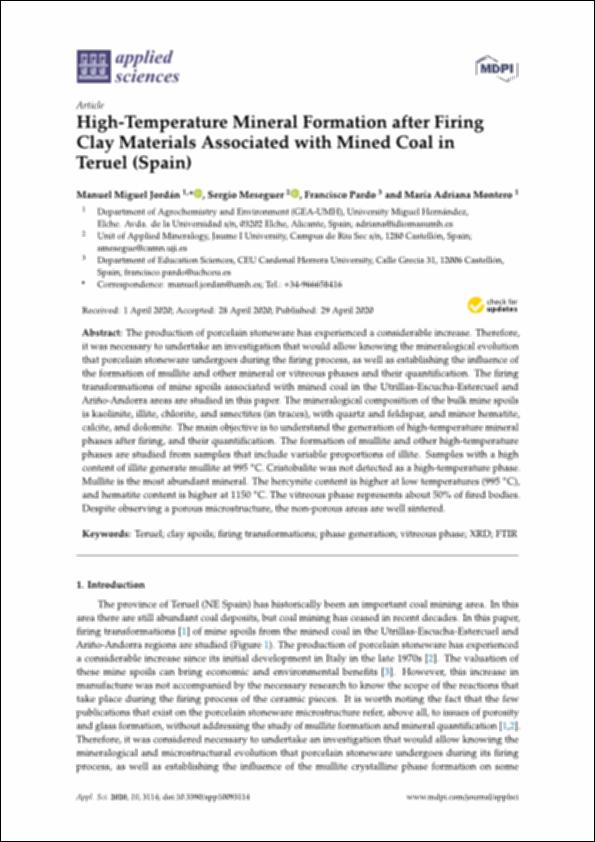Por favor, use este identificador para citar o enlazar este ítem:
http://hdl.handle.net/10637/12569High-temperature mineral formation after firing clay materials associated with mined coal in Teruel (Spain)
| Título : | High-temperature mineral formation after firing clay materials associated with mined coal in Teruel (Spain) |
| Autor : | Jordán Vidal, Manuel Miguel Meseguer Costa, Sergio Pardo Fabregat, Francisco Montero Martínez, María Adriana |
| Materias: | Clay - Analysis - Spain - Aragon - Teruel (County); Arcillas - Análisis - España - Aragón - Teruel (Provincia); Ceramic materials - Analysis - Spain - Aragon - Teruel (County); Mineralogy - Analysis.; Materiales cerámicos - Análisis - España - Aragón - Teruel (Provincia); Mineralogía - Análisis. |
| Editorial : | MDPI |
| Citación : | Jordán, M.M., Meseguer, S., Pardo, F. & Montero, M.A. (2020). High-temperature mineral formation after firing clay materials associated with mined coal in Teruel (Spain). Applied Sciences, vol. 10, i. 9 (29 apr.), art. 3114. DOI: https://doi.org/10.3390/app10093114 |
| Resumen : | The production of porcelain stoneware has experienced a considerable increase. Therefore, it was necessary to undertake an investigation that would allow knowing the mineralogical evolution that porcelain stoneware undergoes during the firing process, as well as establishing the influence of the formation of mullite and other mineral or vitreous phases and their quantification. The firing transformations of mine spoils associated with mined coal in the Utrillas-Escucha-Estercuel and Ariño-Andorra areas are studied in this paper. The mineralogical composition of the bulk mine spoils is kaolinite, illite, chlorite, and smectites (in traces), with quartz and feldspar, and minor hematite, calcite, and dolomite. The main objective is to understand the generation of high-temperature mineral phases after firing, and their quantification. The formation of mullite and other high-temperature phases are studied from samples that include variable proportions of illite. Samples with a high content of illite generate mullite at 995 C. Cristobalite was not detected as a high-temperature phase. Mullite is the most abundant mineral. The hercynite content is higher at low temperatures (995 C), and hematite content is higher at 1150 C. The vitreous phase represents about 50% of fired bodies. Despite observing a porous microstructure, the non-porous areas are well sintered. |
| Descripción : | Este artículo se encuentra disponible en la siguiente URL: https://www.mdpi.com/2076-3417/10/9/3114 Este artículo pertenece a la sección especial "Materials". |
| URI : | http://hdl.handle.net/10637/12569 |
| Derechos: | http://creativecommons.org/licenses/by/4.0/deed.es |
| ISSN : | 2076-3417 (Electrónico). |
| Fecha de publicación : | 29-abr-2020 |
| Centro : | Universidad Cardenal Herrera-CEU |
| Aparece en las colecciones: | Dpto. Ciencias de la Educación |
Los ítems de DSpace están protegidos por copyright, con todos los derechos reservados, a menos que se indique lo contrario.


